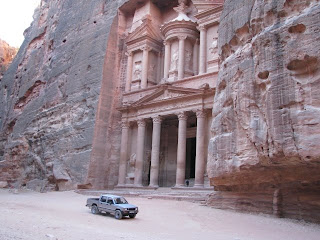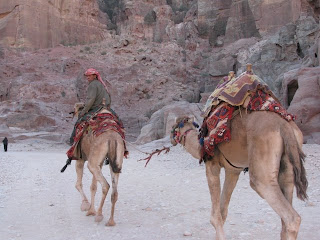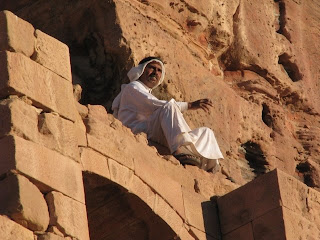
Oh boy, this post is going to be difficult to write. Let me start by saying that Peter and I both agree that Petra is a spot that completely met all of our expectations. That is really saying a lot. It is beautiful, atmospheric, and really, really impressive. If it's not already on your list of things to see, it absolutely should be!
I'm going to use the space to post more than the usual number of pictures, since they really convey best the sense of the place. I'll put in captions where I think they are necessary.
But a LITTLE background (I just can't help myself). Petra, sometimes called the "Rose-Red City" was dug primarily out of the sheer rock of the canyons and gorges just north of the Wadi Rum desert in southern Petra. It was constructed by a civilization called the Nabateans. Historians don't know exactly where they came from, but they took over this area from the Edomites. They inhabited the site of Petra, their capital, from approximately the 3rd century BC through the 1st century AD, when the Romans moved in, made them allies, then more or less absorbed them (apparently). At the height of its glory, the city housed probably 20,000 people. The Nabateans were obviously a very advanced civilization, as you can see plainly from looking at their buildings. They also were a literate society, and archaeologists and linguists have deciphered their writing, the cursive form of which was actually the basis for the modern Arabic alphabet. We know who their gods and goddesses were, and a little bit about their way of life.
Most of the monuments you will see in these pictures were constructed by the Nabateans in the 1st century BC, although the theater is later, from the Roman period, as are a few of the temples. Also, most of what you will see are tombs and structures related to religion.
The people in the pictures are Bedouins. They have inhabited this area for centuries. In the 1980s, the Jordanian government built a nice little community for them outside the Petra park, but about 35 families have moved back into the park and live in some of the Nabatean rock-cut constructions scattered throughout the area. The others come into the park everyday. They make their living by selling handicrafts to the tourists, and giving rides on horses, donkeys and camels. It's very tempting to take them up on those -- the site is huge! Before you even really get in, it is a mile on foot from the gate to the city: a half mile through a valley and another half mile through the siq (see below). I don't know how many miles we walked (and climbed) that day, but we certainly got our exercise.
So now I'll start your "tour" of the site, and post the pictures in the order that we visited the various areas. I'll also write a few impressions here and there:

WALKING THROUGH THE SIQ, YOU CAN ADMIRE THE NABATEANS' ENGINEERING ABILITY: SEE THE WATER TROUGHS THAT RUN ALONG BOTH SIDES? IT GOES ALL THE WAY FROM A DAM IN THE VALLEY INTO THE CITY. IT WAS COMPLETELY ENCLOSED LIKE A MODERN PIPE, BUT IS NOW OPEN. THE PAVING STONES ARE ALSO ORIGINAL!

THE SIQ GETS NARROWER AND NARROWER, AND DARKER AND DARKER, THEN SUDDENLY, THERE IT IS! THE "TREASURY", THE MOST FAMOUS MONUMENT IN PETRA.

OK, SO NOT ALL BEDOUINS RIDE CAMELS AND DONKEYS. BUT THE TRUCK DOES GIVE YOU AN IDEA OF THE SCALE!
We were almost the first people there -- two young men made it in ahead of us, but we never saw them again. Until noon when we came down to the main area for lunch, we had the place mostly to ourselves, besides the Bedouins. That is really rare!

SOME BEDOUINS IN FRONT OF ONE OF THE TOMBS THAT IS NOW UNDER SCAFFOLDING (OF COURSE).

PETRA TAXI SERVICE

THIS HAS TO BE THE WORST JOB IN THE PLACE
The first thing we did was climb to the "High Place of Sacrifice." As advertised, it was high. Along the way, we acquired a kitty "guide" who climbed with us most of the way in return for some cheese and water.

Here are some views of, and from, the High Place of Sacrifice:


THE TOMB OF AARON ON THE HIGHEST MOUNTAIN IN PETRA: THREE HOURS BY HORSE PLUS A THREE HOUR CLIMB AWAY.
On our way back down by a different route, we saw quite a few monuments, and met some Bedouins:

PETER INSPECTS THE TRICLINIUM TOMB

THE INTERIOR OF THE TRICLINIUM IS CARVED, TO TAKE ADVANTAGE OF THE BEAUTIFUL NATURAL PATTERNS IN THE ROCKS

THE NABATEANS ALSO CARVED IMAGES INTO THE CLIFF FACES. THIS IS THEIR GODESS, AL-UZZA, WHO HAD THE FORM OF A LION.
Sometimes, as we climbed the rocks, we heard sounds that we could not identify, and we could not see any source for them. They might have been birds, animals, or maybe even the Bedouins. They must have some language they can use to communicate over a great distance in these canyons. There is also a certain type of bird that lives there that mimics the sound of a laughing child, so we often did not know what we were listening to. The donkeys and camels also often made loud noises that echoed around off the rocks.
We saw many Bedouin women and their children. Many of the women have tattooed faces.

THIS BEDOUIN GIRL WAS SORTING ROCKS TO SELL TO TOURISTS

HER FAMILY ALSO HAD A BABY GOAT THAT THEY WERE MILKING WITH A BOTTLE

THIS IS A VIEW FROM THE OLD MUSEUM, WHICH IS IN ONE OF THE CAVE-STRUCTURES. I LIKE IT BECAUSE IT PROVES HOW FEW PEOPLE WERE THERE THAT DAY. FEBRUARY IS THE PERFECT TIME TO VISIT!
After a break for an awesome buffet meal, we were ready for another adventurous climb, this one up more than 800 stairs (some original, carved Nabatean stairs, some put in for the benefit of modern tourists). Our goal this time was the largest monument in Petra, know as the Monastery. It is on another peak opposite the High Place of Sacrifice. There were more tourists making this trek than to the High Place, but we still had some of the trail to ourselves. We could have taken donkeys, but we didn't.

It is difficult to describe what it is like to come to the top of the mountain, turn a corner, and see this massive construction. It may have been a temple, and it was almost definitely used as a church after the Nabateans converted to Christianity in the 4th century -- there are many crosses carved on the inside, although we did not go in.

CAN YOU FIND ME?

THERE I AM! I WAS IMPRESSED WITH MYSELF FOR CLIMBING THAT BIG ROCK UNTIL I SAW THIS YOUNG BEDOUIN GUY:

LOOK AT THE PICTURES OF THE MONASTERY AGAIN. HE IS HANGING FROM THE VERY TOP! SHOWOFF!
From There, there was only one place we could go:



A JORDANIAN SCARECROW?
From the viewpoint at the "End of the World" we could see the Arabian Desert stretching out just beyond the mountains. That adventure will have to wait for another trip.


YOU CAN SEE THE ARABIAN DESERT BEYOND THE MOUNTAINS.
By the end of the day we again had the place almost to ourselves, again except for the Bedouins:

WAIT A MINUTE...THIS ISN'T QUITE RIGHT!

DOING HOMEWORK ON THE WAY HOME ON THE "SCHOOLBUS"
We took the advice of a young Bedouin and climbed to the platform of one of the Royal Tombs to watch the sun set. We were not the only ones with the idea:


WATCHING THE SUNSET FROM THE ROYAL TOMBS

HAVING A SMOKE AT DAY'S END
Below us, a Bedouin boy sauntered by on his donkey, playing on some kind of flute. Besides that and the sounds of the camels who were restive at the end of the day, it was completely peaceful. After the sun went below the horizon, we made our way back to the entrance. By the time we were halfway back through the siq it was almost completely dark and very, very still. Thankfully, it was light enough outside the canyon to easily find our way back along the road to the visitor's center. Along the way we turned down one last offer for a horseback ride to the gate -- VERY tempting at that point! When we got back to the entrance, we had to stop for one more picture:

ME AND MY HERO!
We left Wadi Musa right away and drove back to Madaba for the night. We took the Desert Highway this time, because we knew it was straight, and thought it would be faster. We had no idea that it had speed bumps every few miles. Imagine, a highway with speed bumps! Also, the guy at our hostel had told us there would be somewhere to stop and eat on the way. Sure, if you count butcher shops with big raw hunks of eat hanging in the windows. Apparently there is no concept of fast food in Jordan, or of having any kind of services along the main highway. We did not want to wander off into a little town in the dark with no idea of where we were going, so we stuck it out and got back to Madaba almost 3 hours later, very hungry and kind of cranky. The owner of our hotel was kind enough to order food sent over for us. I guess that's the kind of service you get when you are the only guests in the place.

2 comments:
The green-eyed monster of jealousy rears its ugly head again! I'm so glad you got to experience that and are willing to share with the rest of us. Next time you go, I'm coming. Just count on it. :) Take care you two!!!
Christina
Candy, Amazing! Too many questions. I will have to look up more information. The pictures are great. Too bad you didn't ride a camel at least part of the way.
love you,nonnie
Post a Comment